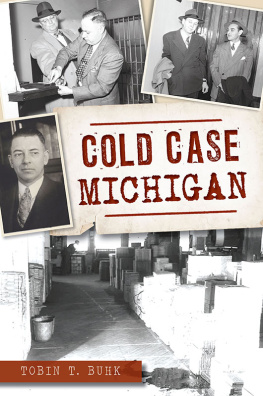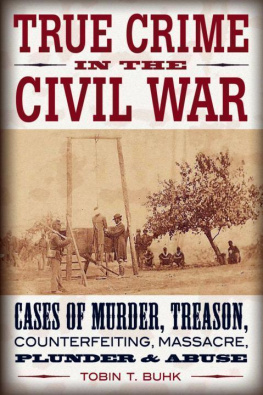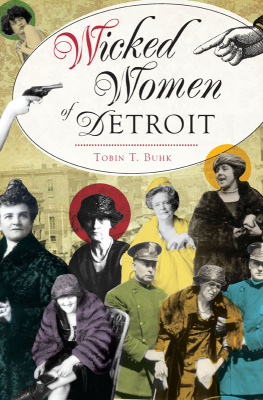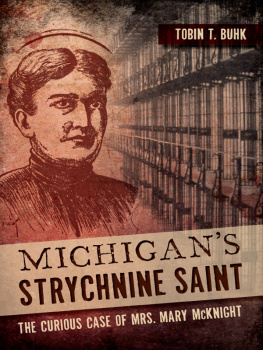

Published by The History Press
Charleston, SC
www.historypress.com
Copyright 2021 by Tobin T. Buhk
All rights reserved
First published 2021
E-Book edition 2021
ISBN 978.1.43967.357.7
Library of Congress Control Number: 2021941627
Print Edition ISBN 978.1.46714.873.3
Notice: The information in this book is true and complete to the best of our knowledge. It is offered without guarantee on the part of the author or The History Press. The author and The History Press disclaim all liability in connection with the use of this book.
All rights reserved. No part of this book may be reproduced or transmitted in any form whatsoever without prior written permission from the publisher except in the case of brief quotations embodied in critical articles and reviews.
Contents
Everyone Likes a Whodunit
A Brief Introduction to Cold Case Michigan
My fatal attraction to historic cold cases began one sunny July day at Heathrow Airport, where I discovered Jack the Ripper.
That summer, my brother and I backpacked across Europe. On the British Airways flight to London, we watched what seemed like a never-ending newsreel of cricket highlights. Despite the five hours of watching cricketers in action, I did not, do not and probably never will understand the game of cricket.
While in Heathrow awaiting the return flight, I faced a choice: watch five more hours of cricket highlights or find another way to pass the time. So I wandered into a shop and began perusing books. Thats when I spotted Donald Rumbelows The Complete Jack the Ripper.
It was love at first fright. Over three decades have passed from that fateful moment when I became an amateur Ripperologist and an aficionado of historic true crime.
Jack never visited the Great Lake State (that I know of), but that doesnt mean that Michigan does not have its share of notable unsolved crimes, including Ripperesque murders, the slaughter of entire families, closed-room murders and even a headhunter on the loose.
So why, might the skeptical reader ask, should I pay attention to old, cold cases?
I offer three reasons. One: because identifiable patterns of human behavior exist and have led to profiles compiled over the years, such cases can prove instructive to the student of criminal behavior. Two: if nothing else, they serve as morbid reminders that those ignorant of history will be condemned to repeat it. Three: no matter how much water has flowed under the bridge, the victims of unsolved crimes deserve justice, even if belated by a century, and there is no statute of limitations on murder. Perhaps something between these covers will remind a reader of that suspicious letter found in a trunk in the attica letter that contains some clue that may lead to the closure of a centuries-old cold case.
Back to Jack the Ripper. Over 130 years later, the case still lingers in books churned out annually by scores of so-called Ripperologists. Students of the case revisit crime scenes, weigh the evidence and debate suspects all because of the possibility that someday, even after all this time, someone will find the knife and the hand that used it.

Inevitably, with a book like this, some readers will wonder about some famous unsolved cases that did not make the cut. Yes, they might ask, but what about?
There are literally hundreds of cold cases in Michigan history, enough to fill several volumes. Alas, I had to make some tough decisions about which ones to include. To select the best stories for inclusion, I followed a few simple guidelines:
The crimes had to be headline cases in their respective eras and not obscure matters or minor footnotes in the annals of crime in the Great Lake State. Such footnotes always make interesting reading but do not qualify as the most infamous unsolved crimes in Michigan history. They also tended to elude the historical record, making verification of facts difficult if not impossible.
The cases had to be verifiable crimes and not the product of suspicion, folklore, rumor or gossip, although all four of these ingredients are required in cooking up a really good cold case story.
The crime could not be written about so much that it became the yesterdays news of yesterdays news, which brings me back to Yes, but what about? The Hoffa case, for example, ranks at the top of unsolved Michigan crimes, yet whole libraries on the case exist.
Alas, the reader will not find Jimmy Hoffa buried in these pages. Instead, the reader will find the slaughter of a family, a headhunters relics, a closed-room murder, the slaughter of another family, an assassination, a murder without motive or suspects, another assassination and other crimes that will strain the little grey cells, to borrow an expression from Hercule Poirot.
Each old cold case is like a nonfiction game of Clue. Between these covers, readers will find the weapons, the rooms and the suspects, but in this game, the envelope containing the solution remains sealed, the solutions obscured by bungled investigations, crafty criminals who excelled at covering their tracks and the passage of time.
Let the games begin!
The Spiked Club Triple Murder
(Dowagiac, 1921)
The Monroe familyWilliam and Mary and their two daughters, Neva and Ardithlived in a small, lean-to shack on a quiet street in Silver Creek Township at the northwest edge of Dowagiac. On the afternoon of Tuesday, September 20, 1921, an eight-year-old neighbor calling on Ardith Monroe stumbled upon one of the grisliest crimes in the history of Southwest Michigan. It has no parallel in Cass county and perhaps there is none in Michigan, wrote a reporter for the Dowagiac Daily News in his page-one item of Thursday, September 22, 1921.

Grace McKee stood on the front porch and called for Ardith Monroe. The eight-year-old wanted to see if her friend, the younger of the two Monroe daughters, could come out to play. When no one answered, she rapped on the door a few times. Still no answer, but it seemed like the family was home, so Grace gingerly opened the front door and went inside. The floorboards creaked under her feet as she tiptoed into the bedroom. As the sun began to drop below the horizon, the last rays of daylight spilled into the room from the gaps around the drawn window shades. The large room contained two steel beds, one shared by husband and wife, the other by the sisters.
When her eyes adjusted to the darkness, Grace noticed Ardith sitting in the corner with her back pressed against the bedroom wall. Her face was the color of a porcelain doll. A streak of dried blood ran from a gash on her temple just below the hairline down the right side of her face. She stared at the bed and did not appear to notice when her friend entered the room.
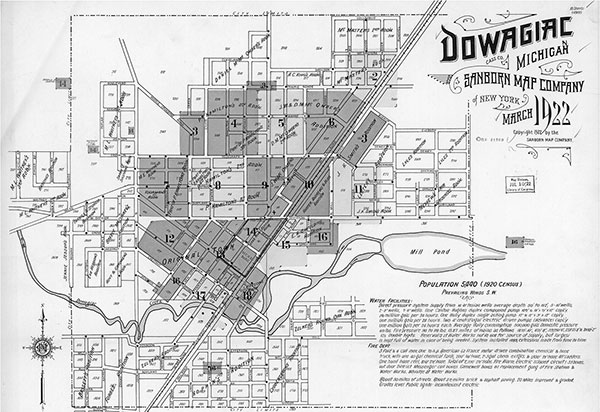
Sanborn Fire Insurance Map showing Dowagiac in 1922. Library of Congress Geography and Map Division.
Grace McKee followed Ardiths gaze and saw a motionless silhouette stretched across the bed. She let out a yelp and darted out of the house, screaming.
Grace sprinted home. Her mother managed to decipher the jumbled mass of adjectives and called Mary Monroes brother Ralph Gillette, who immediately went to investigate. Meanwhile, neighbors who heard Graces screams also called the police. Gillette and a small contingent of neighbors arrived just before the police, and in handling several vital pieces of evidence, they inadvertently tainted the crime scene.
Next page
